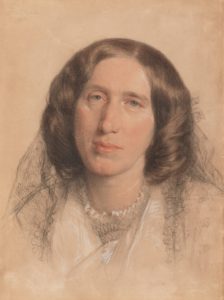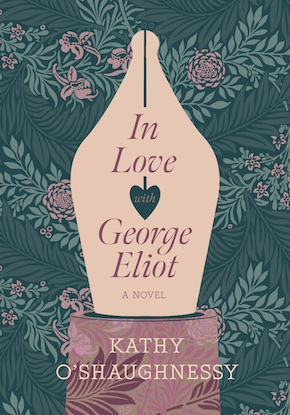This great horse-faced bluestocking
by Mika Provata-CarloneThere are books that have transformed the world; stories that have changed the course of lives. For more than 150 years now, the novels of George Eliot (Mary Ann Evans) have done just that for an unwavering and undiminishing succession of readers: they have stopped them in their tracks almost midway, literally nell mezzo del camin – to put it rather obviously, in middle march, since Eliot’s reference to Dante and his Commedia in her works is perhaps the one indubitable fact about her. The intense psychological and social situations, the formidable intellectual forays into the human psyche that they contain, have led to a multitude of conversions, reversals, transfigurations – individual but also communal.
In art, and also in life, Eliot was an incandescent figure of private solitude and public multitude, radical, oracular, incarnating at one and the same time the quintessence of an entire tradition – not just of English literature or of Englishness, but of the European dream for a humanistic dialectics, a project of the mind and the soul that thirsted for the metamorphic fusions and stark solipsism of the individual trajectories of separate nations, of ways of reflection, of life and aesthetic perception. Henry James confessed that he could not resist the spell Eliot cast left and right, far and wide: “Behold me literally in love with this great horse-faced bluestocking,” he would declare, unresisting before this “magnificently ugly, deliciously hideous” yet unquestionable literary godhead.
Eliot is a remarkable figure not only in terms of what she produced by way of writing, translating and essayistic correspondence, but especially in terms of the way she brought forth new ways of thinking, of expression, of human interaction across genders, social classes, cultural categories and philosophical doctrines. To read about what Eliot read in order to write is almost magnificently overwhelming, to pick up James’ trope. To trace the growth of her consciousness through her interaction with the most extraordinary and so many of the most ordinary intellects and personalities of the time is outright dizzying. To contemplate the influence she has had on those who followed is no mean feat. So how does one even attempt to recover the life of such a past, the immanence and timelessness of a single woman who embodied so very many voices and lives?
Eliot is Balzac and Tolstoy combined, Thomas Hardy avant la lettre and revised, she is, above everything else, quite simply unique.”
To mark the bicentenary of her birth, several books have sought to capture the Innerlichkeit of Eliot, that strange and astonishing inner power that places her beyond the grasp of the Brontës, at a tongue-in-cheek counterpoint with Jane Austen, in an eerie tension with Charlotte Perkins Gilman or Kate Chopin. Eliot is Balzac and Tolstoy combined, Thomas Hardy avant la lettre and revised, she is, above everything else, quite simply unique. Among the most evocative and masterful recent engagements with her are Rebecca Mead’s My Life in Middlemarch (2014), alongside Philip Davis’ The Transferred Life of George Eliot (2017), and Nancy Henry’s The Life of George Eliot (2012). It is a crowded space, yet certainly not a saturated one, and Kathy O’Shaughnessy seems daringly intent to prove this point with her own biopic-cum-novel In Love with George Eliot.
O’Shaughnessy opens her story, aptly enough, with a meeting between an author and a publisher, and promises a portrait of the woman artist as an ur-primer for the generations to follow. Her book starts with a strong drive for new ideas, radical, unprecedented revisions, for a more central position for the women in Eliot’s story, and a more reflective one for men. It is a book that will appeal to those who are already in love with Eliot, like James or even more so, and to those who have never read her, and feel they must begin the journey somewhere safe before launching upon the dangerous crossing of her vast seas of words and pages.
The conceit of In Love with George Eliot is simple and rather engaging: an alter ego of O’Shaughnessy herself (or perhaps not) undertakes to write a fictionalised life of Eliot by capturing the voices in her letters, by unfading the colours of dresses and home fabrics long turned to musty dust, and especially by turning up the volume of the echoes of Eliot’s words in the protagonist’s own ears and in those of others who read Eliot, study her, live by her or make a living off her. O’Shaughnessy’s narrative threads together real lives, literary figures and fictional modern characters by creating existential parallels of sorts, in what has become a familiar template – one that emphasises the value of an artist or a work of art almost exclusively through its identification with and its effect on the beholder.
O’Shaughnessy is a sharp observer, a keen reporter, a daring and adoring reader between the lines, across primary and secondary material. She has an eye for patterns, for the figures in the carpet, for the semiotics of relationships, such as bigness and smallness, tight-fitting, streamlined shapes and expansive forms. Cultural markers become a language that decodes and deconstructs, providing a hierarchy of being and perceiving. Social structures are anatomised, exposing the feelings and the senses, the mind and the stark claims of the New Age of Reason, its pitfalls and temptations. Masters and mistresses, and the unchallenged dominion of undivorceable wives demarcate points of departure, transgression or compliance, and O’Shaughnessy’s writing, which is intensely descriptive, aims to analyse the female experience of feeling empowered, self-reflexive, individual, a centre and no longer a mere satellite. Eliot has a feverish, encyclopaedic curiosity, combined with a formidable capacity of insight, lateral or cross-sectional connections, for going deeply into things. It was what attracted James to her, and perhaps what daunted Nietzsche, who famously dismissed her. O’Shaughnessy tries hard to match her heroine, or at least to provide her with the textuality and textural relief and vitality that will convey the mesmeric pathos, her innate idolatrising allure.
She astutely creates the space for her reader to engage thrillingly with Eliot’s revelations about the female creative psyche, the dichotomy or synergy between female genius, femininity and motherhood.”
In Love with George Eliot is in many, wondrous ways an absorbing book. At its heart is Herbert Spencer’s comment about Eliot that she was suffering from “a double consciousness”, that she was constantly aware of whatever she was saying as she was saying it, that she listened to herself in a critical way. For Spencer, this was a pitiable, tacitly female condition, yet in O’Shaughnessy’s hands it becomes a double reflector with which she seeks to both dislocate and focus the reader’s own critical attention and self-perception. She astutely creates the space for her reader to engage thrillingly with Eliot’s revelations about the female creative psyche, the dichotomy or synergy between female genius, femininity and motherhood.

Portrait of George Eliot by Sir Frederic William Burton, 1865. National Portrait Gallery
This double vision, which extends to the reader’s own understanding of agency, identity, voice and authority, has a particular resonance at a time when the value of the humanities as a field of human enterprise, and as an academic discipline, as a way of defining ethical and existential belonging or even civic relations, are being pilloried ad nauseam, as is the sense of indebtedness to a tradition, or the gesture of recognition and even admiration towards works of art, in any form, as being masterpieces of their craft, and to their authors as being those who strove to hone their skills beyond the common measure. O’Shaughnessy’s doppelgänger, Katie Boyd, is figured here as the recoverer and restorer of such a closer, acknowledged intimacy with the sense of legacy and tutelage, with the human continuity that is the sine qua non condition of all human change. She is portrayed as standing between blinkered disciples of Eliot as a sacred monster and mercantilist academics profiteering from the latest critical (or uncritical) theoretical trend. She figures especially as a woman of heightened sensibility, seeking the companionship of another female voice and experience. A thorough, unflinching researcher, she seeks to revive the human individual behind the awesome edifice, and from that perspective In Love with George Eliot is a true cornucopia of immersive Eliot moments, a time capsule of private encounters with Eliot and with Eliot’s world. O’Shaughnessy clearly intends to emphasise the inalienable relevance of Eliot and of figures like her, of works of such calibre and human depth, and her novel is a formidable tribute to that purpose.
There are however significant weaknesses. It would have profited from a stricter, less self-indulgent decluttering from what can feel at times a rather cloying narrative over-ornamentation, and from certain factual errors. Also from a more objective, less sentimentalised analysis of all that constituted Eliot’s genius and personal magnetism. As it is, the reader is often left baffled by an overriding sense of disjunction between Eliot as a private woman of her time, as an individual observed in the pursuits of everyday life, and the remarkable writerly persona that emerges through what are no less than epic reading quests, moments that O’Shaughnessy presents as almost manic Joycean epiphanies that alone produced her writings.
In Love with George Eliot presumes a close familiarity with Eliot’s work as regards plot, characters, reception, revolutionary impact, and intimate knowledge (a partaking, one might say) of the ‘pervading cultural aura’ of the times, to use Auguste Comte’s term that Eliot was so struck by. It assumes nothing comparable as regards the quotidian aspects of life, the material culture, domestic trivia etc., and O’Shaughnessy takes great relish in setting up that stage for her reader, and in populating it profusely with minor and major (real or extrapolated) figures of her drama. The novel, consequently, treads gingerly between what James Wood termed ‘hysterical’ and ‘commercial’ realism, resulting in a certain imbalance, yet again, between the annalistic, historical-materialistic perspective, and the process of becoming of the individual genius, the understanding of the extraordinary mastery of narrative, talent, human intuition and sheer intellectual acuity that Eliot achieved through a conscious effort of progression, and an acknowledgement of the need to be a learner, even of humility, before professing to have attained her unquestioned, formidable grandeur.
Such a progression is moreover at the heart of Eliot’s characters, whether seen from within the entropic system of individual novels, or in the broader context of the extraordinary cosmos of her work as a whole. From first to last, Eliot seeks to refine, distil and locate the quintessence of what emerges invariably as the human condition, the ultimate choice and equilibrium between good and evil. O’Shaughnessy’s Eliot risks a conflation between greatness or a larger-than-life dimension and mere celebrity, between charisma and a public image that is almost an ironic inflation of a unique presence and voice. An obvious issue is the internalisation of Edith Simcox, an Eliot ‘fan’ who combined flatness with intriguing complexity, in so much of the linguistic and stylistic register, although O’Shaughnessy must be credited here for reproportioning Simcox’s importance for Eliot, contrary to many of Eliot’s biographers. This attempt for a ‘historical timbre and sound’ at times weighs down the story rather heavily, bringing to mind the words O’Shaughnessy has Lewes say at one point: it can all seem like “Casaubon without the fun.”
Perhaps sometimes the ordinary, rather than the extraordinary life is the one we yearn for most, and find more sustaining.”
O’Shaughnessy’s Eliot has a rich inventory of minutiae, of unguarded glimpses and views from the wings. Yet in her effort to construct a parallel between Eliot and the contemporary characters that is almost unbearably tight at the seams, what is sacrificed is the true sense of interiority, the depth and richness of presence, of intellectual life one would have expected of Eliot. Instead, the driving force in the narrative seems to be an elaborate unsophistication, an unsettling sense of self-preoccupation. For all the emotionality and pathos injected in the narrative throughout, there is something formulaic and even constrained in the overall effect, a militant polemic for a certain ‘type’ of George Eliot. A missed opportunity is the historical character of Maria Terpsithea Cassavetti-Zambaco, who receives a tenuous and particularly hostile treatment. The daughter of a wealthy merchant, she was an artist of remarkable talent and a key Pre-Raphaelite muse. Together with her two cousins, Marie Spartali Stillman and Aglaia Coronio, all three of Greek descent, they were known as the Three Graces of the Pre-Raphaelite artists. Perhaps even more regrettable is the loss of the sense of spirituality that was so vital to Eliot, whether as a quest, an agon, a challenge or a yearning.
If one were to judge it harshly, In Love with George Eliot might perhaps be more fittingly described as une vie romancée, a term which highlights rather sombrely the tendency to tame and beautify that has beleaguered so much of women’s writing. With a subject like Eliot, the hope is that a voice that broke the glass ceiling of literary success, both in terms of quality and market presence, can also inspire a comparable if not equal clarity, quiet confidence, faith in the purpose and place of its utterance. And yet perhaps sometimes the ordinary, rather than the extraordinary life is the one we yearn for most, and find more sustaining. O’Shaughnessy offers us a luxurious view of Eliot’s domesticity and life motions: read in conjunction with Eliot’s work, In Love with George Eliot can make the daring claim of providing the living mise en scène, of reviving the ordinary hues and colours of an extraordinary tableau.
 Kathy O’Shaughnessy is a reviewer and critic who has worked as Deputy Editor on the Literary Review, Arts & Books Editor of Vogue, Literary Editor of The European and Deputy Editor of The Telegraph Arts & Books. Her stories have been published in Faber’s First Fictions, and she edited and introduced Drago Stambuk’s poems, Incompatible Animals. In Love with George Eliot is published by Scribe in hardback and eBook.
Kathy O’Shaughnessy is a reviewer and critic who has worked as Deputy Editor on the Literary Review, Arts & Books Editor of Vogue, Literary Editor of The European and Deputy Editor of The Telegraph Arts & Books. Her stories have been published in Faber’s First Fictions, and she edited and introduced Drago Stambuk’s poems, Incompatible Animals. In Love with George Eliot is published by Scribe in hardback and eBook.
Read more
@ScribeUKbooks
Mika Provata-Carlone is an independent scholar, translator, editor and illustrator, and a contributing editor to Bookanista. She has a doctorate from Princeton University and lives and works in London.


